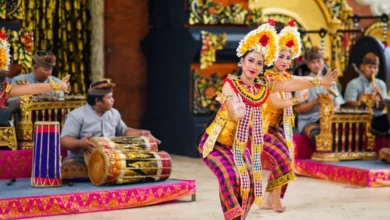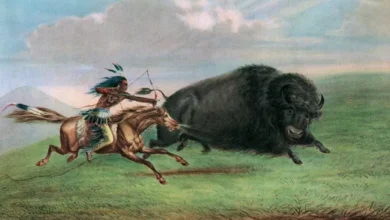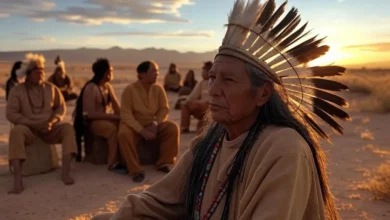In the starkly beautiful landscapes of Namibia’s Kunene Region, where the earth blazes ochre under an unrelenting sun, the Himba women stand as timeless custodians of culture.
As the last semi-nomadic people of Namibia, the Himba have carved out an existence in harmony with the land, their lives a testament to resilience, beauty, and profound connection to ancestry. At the heart of this society are the women, whose roles as nurturers, artisans, and spiritual guides weave the fabric of Himba identity.

A Day in the Life: Strength and Serenity
As dawn breaks over the Kaokoland, Himba women rise to tend their homesteads, known as ongandas. These circular enclosures of mud-and-dung huts, shaded by mopane trees, hum with activity. Women milk goats, their hands moving rhythmically, while children play nearby. The men, often away herding cattle, entrust the women with managing the home—a responsibility embraced with quiet authority.
The day unfolds with tasks passed down through generations: grinding maize into flour, crafting iron jewelry, and repairing huts with a mix of clay and livestock dung. Amid these chores, laughter and storytelling bind the community, ensuring oral histories and traditions endure.
See also The Yoruba People of West Africa
The Yoruba People of West Africa

Otjize: The Crimson Veil of Life
The Himba’s luminous red skin, a hallmark of their identity, is adorned with otjize, a sacred paste of red ochre, butterfat, and aromatic resin from the omuzumba shrub. Applied daily, this ritual transcends aesthetics:
- Protection: Otjize shields against the desert sun and insects.
- Spirituality: The red hue symbolizes Earth’s lifeblood, linking wearers to their ancestors.
- Identity: For girls, the first application at puberty marks their entry into womanhood, celebrated with songs and dances.
Women mix otjize with meticulous care, their hands stained crimson as they anoint skin and hair, transforming themselves into living embodiments of their heritage.
Hairstyles: A Language Woven in Hair
Himba hairstyles are a visual lexicon, narrating age, status, and lineage:
- Childhood: Girls wear two plaited ondato braids forward-facing.
- Adolescence: After puberty, multiple braids cascade down, adorned with iron beads.
- Marriage: A bride’s erembe headdress, crafted from sheepskin, signifies her new role.
- Motherhood: Elaborate styles, often coated in otjize and shells, celebrate fertility.
Each braid and bead carries meaning, a silent dialogue between tradition and individual journey.
See also San Bushmen: The Ancient Hunter-Gatherers of Southern Africa
San Bushmen: The Ancient Hunter-Gatherers of Southern Africa




Spirituality: Ancestors in the Wind
The Himba’s world is steeped in reverence for ancestors (ovakuru), believed to mediate between the living and God (Mukuru). Women lead rituals at the okuruwo (ancestral fire), kindling flames that bridge worlds. During the Okuze ceremony, they invoke blessings for rain and health, their chants echoing across the desert.
Cattle, central to Himba cosmology, are more than wealth—they are spiritual kin. A woman’s dowry, paid in cattle, cements familial bonds and ensures ancestral favor.

Challenges: Navigating a Changing World
The Himba’s nomadic rhythms face modern tempests:
- Climate Change: Prolonged droughts threaten cattle herds, forcing painful adaptations.
- Land Rights: Encroachment by mining and tourism sparks tensions; the 2013 Otjimboyo land grab remains a bitter memory.
- Tourism’s Double Edge: While cultural tours generate income, they risk reducing traditions to spectacles. Ethical initiatives, like the Himba Cultural Village, strive to balance education and respect.
Yet, the women innovate: selling handcrafted jewelry, embracing solar power, and advocating for land rights through groups like Namibian Rights and Resources.
Resilience: Threads of the Future
In the face of change, Himba women anchor their community. They teach daughters the click consonants of OtjiHimba, the art of otjize, and the stories etched in stars. Young women like Tijandje Tjambiru, who blends smartphone use with traditional attire, embody a dynamic future.
“Our strength is in our unity,” says elder Mbakumba Tjambiru. “We are like the mopane tree—rooted deep, bending but never breaking.”

Conclusion: A Legacy in Crimson and Dust
The Himba women, with their ochre-glowed skin and braided crowns, are more than relics of a bygone era. They are architects of a living culture, navigating modernity with grace and agency. Their journey reminds us that tradition is not static but a river, ever-flowing, shaped by the hands that cherish it.
In the words of a Himba proverb: “The sun sets but leaves its light in the sky.” So too do the Himba women illuminate the path forward, guardians of a heritage as enduring as the Namibian earth.
To support the Himba, consider ethical tourism or donate to organizations like Survival International, ensuring their voice echoes for generations.
This article honors the Himba’s agency, blending anthropological insight with poetic reverence for their unyielding spirit.




